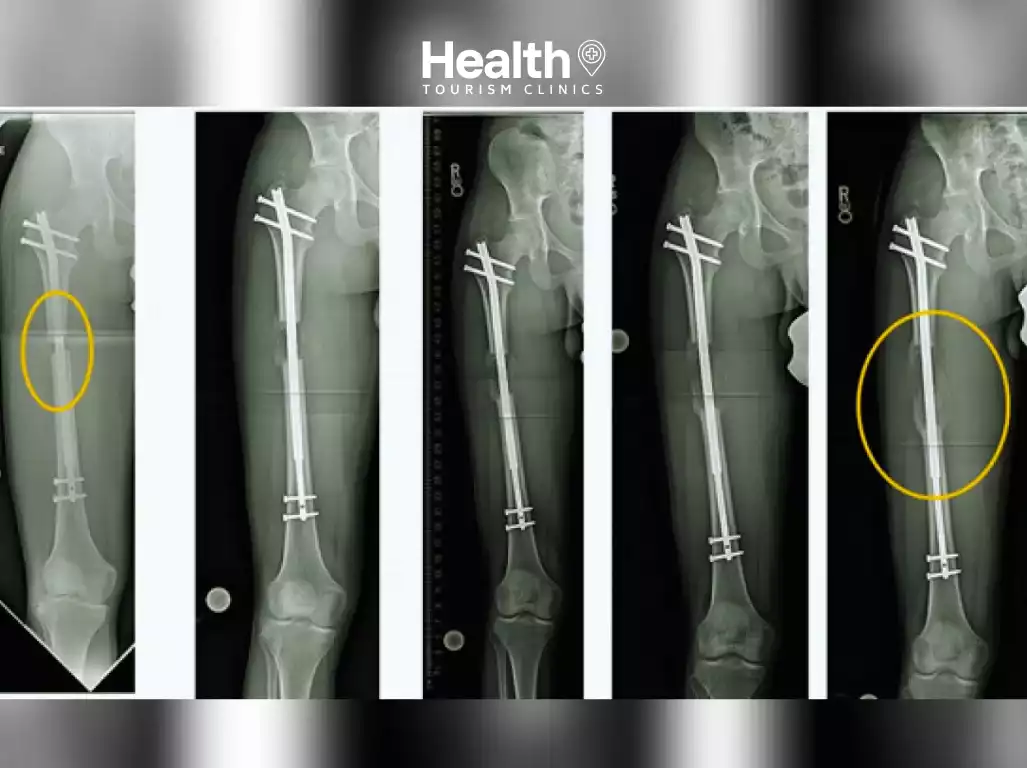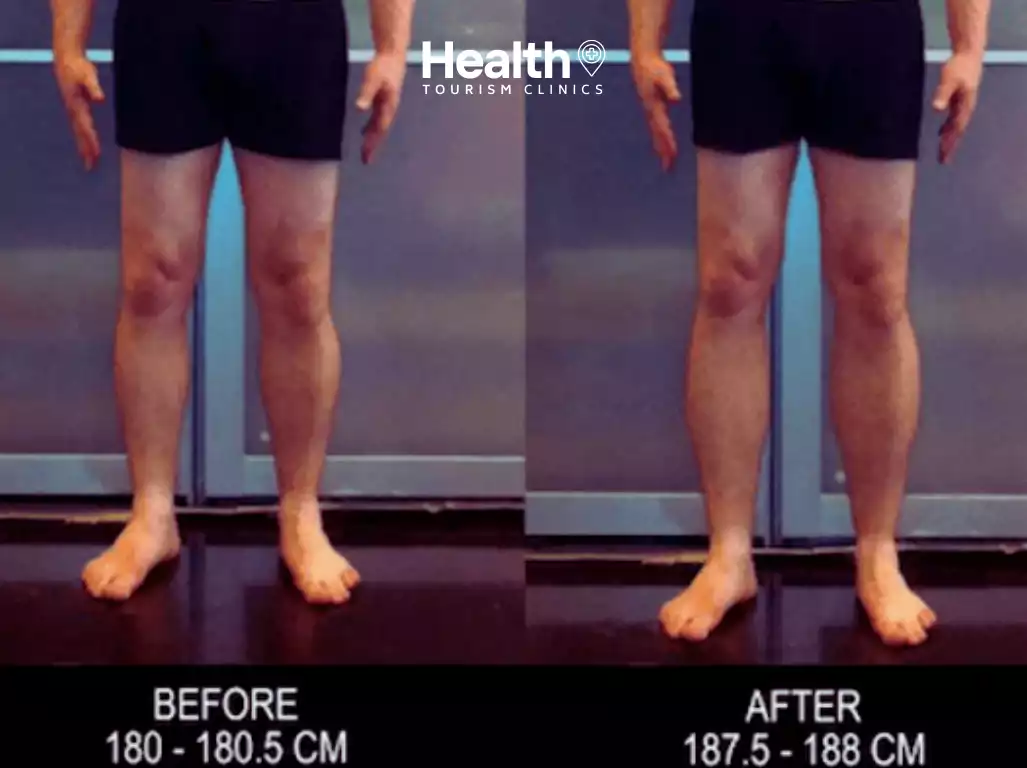
What You Need to Know About Limb Lengthening Surgery
Leg lengthening surgery, also known as limb lengthening surgery or stature lengthening surgery, is a medical procedure designed to increase a person’s height. This surgical method is primarily performed on individuals who have concerns about their height or those who experience a significant height difference between their limbs.
The procedure involves cutting the bone in the leg and using an external or internal fixation device to gradually pull the bone segments apart. This gradual separation stimulates new bone growth, which ultimately increases the length of the leg. Patients undergoing this surgery must be prepared for a lengthy and challenging recovery process, as it can take several months to achieve the desired height increase.
It’s important to note that leg lengthening surgery is a highly specialized and complex procedure, and it is typically reserved for cases where height is a significant concern. Potential candidates for this surgery should undergo a thorough evaluation by a medical professional to determine whether they are suitable candidates for the procedure.
It is crucial to keep in mind that leg lengthening surgery carries risks and complications, and it should only be considered after careful consideration of the potential benefits and drawbacks. Additionally, the decision to undergo this surgery should be made in consultation with a qualified orthopedic surgeon who specializes in limb lengthening procedures.
In summary, leg lengthening surgery is a medical procedure aimed at increasing a person’s height by extending the length of their leg bones. It is a complex and specialized surgery that should be considered carefully, and potential candidates should seek expert medical advice before proceeding with the procedure.

How Is Limb Lengthening Surgery Performed?
Limb lengthening surgery is a complex medical procedure designed to increase a person’s height by extending their leg bones. The surgery is typically performed in the following steps:
- Preoperative Evaluation: Before the surgery, the patient undergoes a thorough evaluation by a specialized orthopedic surgeon. This evaluation includes a medical history review, physical examination, and imaging studies, such as X-rays or MRI scans. The surgeon assesses the patient’s bone structure, health, and determines the extent of the lengthening required.
- Anesthesia: The surgery is performed under general anesthesia to ensure the patient is unconscious and pain-free throughout the procedure.
- Bone Incision: The surgeon makes a precise incision in the patient’s leg, typically in the femur (thigh bone) or tibia (shin bone). The choice of bone depends on the patient’s specific case and desired height increase.
- Fixation Device: Once the bone is exposed, the surgeon attaches an external or internal fixation device. External devices may include an Ilizarov frame, while internal devices could be intramedullary nails. These devices serve to stabilize the bone segments and allow for gradual separation.
- Gradual Distraction: Over several days or weeks, the bone segments are gradually pulled apart using the fixation device. This process stimulates new bone growth in the gap, effectively lengthening the limb. Patients are often required to perform daily adjustments to the fixation device, following the surgeon’s instructions.
- Healing and Bone Growth: As the bone segments separate, the body responds by generating new bone tissue. This process, known as distraction osteogenesis, continues over several months until the desired length is achieved.
- Follow-Up Care: Regular follow-up appointments with the surgeon are essential to monitor the patient’s progress and adjust the fixation device as needed. Physical therapy and rehabilitation may also be part of the recovery process to regain strength and mobility.
- Removal of Fixation Device: Once the desired limb length is achieved, a second surgery is performed to remove the fixation device.
- Rehabilitation: Following the removal of the device, patients continue with rehabilitation to regain full function and mobility of the limb.
It’s important to note that limb lengthening surgery is a major procedure with potential risks and complications, and it requires a significant commitment from the patient in terms of time and effort. Patients considering this surgery should have a thorough discussion with their orthopedic surgeon to understand the process, potential outcomes, and the associated challenges.
Who Are Suitable Candidates for Limb Lengthening Surgery
Limb lengthening surgery is a specialized medical procedure that is not suitable for everyone. The following are factors that typically define suitable candidates for this surgery:
- Height Concerns: The primary reason for considering limb lengthening surgery is a significant concern about one’s height. Potential candidates often have a strong desire to increase their stature.
- Skeletal Maturity: Candidates should have reached skeletal maturity, which typically occurs around the age of 18 for women and 21 for men. This is because the growth plates in the bones need to be closed to ensure the safety and effectiveness of the procedure.
- Good General Health: Candidates should be in good overall health to undergo surgery and the subsequent recovery process. Conditions that affect the body’s ability to heal, such as diabetes or certain blood disorders, may disqualify a person from the surgery.
- Realistic Expectations: It’s important for candidates to have realistic expectations about the outcomes of limb lengthening surgery While significant height gains are possible, there are limits to how much the bones can be extended safely.
- Psychological Evaluation: A psychological assessment may be conducted to ensure that candidates are mentally prepared for the procedure and the challenges it presents, including the lengthy recovery period.
- Commitment: The surgery requires a significant commitment from the candidate. It involves a lengthy recovery process, daily adjustments to the fixation device, and regular follow-up with the surgeon. Candidates must be willing and able to comply with the demands of the procedure.
- Orthopedic Evaluation: A specialized orthopedic surgeon evaluates the candidate’s bone structure, limb alignment, and specific needs to determine the feasibility of the surgery.
- Ethical Considerations: The decision to undergo limb lengthening surgery is a personal one, and ethical considerations should be taken into account. Candidates should be well-informed and have a clear understanding of the potential benefits and risks.
It’s essential to consult with a qualified orthopedic surgeon who specializes in limb lengthening procedures for a thorough evaluation. They can provide personalized advice and guidance based on an individual’s unique circumstances. Ultimately, the decision to undergo limb lengthening surgery should be well-considered and made with a full understanding of the process and its implications.

Risks of Limb Lengthening Surgery
Limb lengthening surgery is a complex and specialized procedure aimed at increasing a person’s height. While it can be successful, it is essential to be aware of the potential risks and complications associated with this surgery. Below are some of the key risks involved:
- Infection: Infection can occur at the incision site or around the implanted fixation device. This risk can lead to serious complications if not promptly treated.
- Pain and Discomfort: Pain is a common side effect after limb lengthening surgery Patients may experience varying levels of discomfort throughout the lengthening process and recovery period.
- Nerve and Blood Vessel Damage: During the surgical procedure or while adjusting the fixation device, there is a risk of damage to nearby nerves and blood vessels, which can result in sensory or motor deficits.
- Joint Stiffness: Lengthening the bone can lead to joint stiffness and reduced range of motion in the affected limb. Physical therapy is often required to address this issue.
- Bone Healing Complications: Delayed or non-union of the bone, where the bone fails to heal properly, is a significant risk. This may necessitate additional surgical procedures or interventions.
- Cosmetic Concerns: Sometimes, the cosmetic appearance of the limb may not meet the patient’s expectations due to issues such as scarring, residual deformities, or limb length discrepancy.
- Psychological Impact: The extended recovery period and physical challenges of the surgery can lead to emotional and psychological stress. Patients should be prepared for the potential psychological impact.
- Fixation Device-Related Issues: Problems with the external or internal fixation device can occur, including device failure, loosening, or breakage, which may require additional surgical interventions.
- Limited Lengthening: The extent to which the limb can be safely lengthened is finite. Attempting to exceed safe limits can lead to severe complications and deformities.
- Cost and Time Commitment: Limb lengthening surgery is expensive, and the time commitment involved in the treatment process can be substantial, often spanning several months or even years.
- General Anesthesia Risks: Like any surgical procedure, limb lengthening surgery carries risks associated with general anesthesia, including allergic reactions, breathing difficulties, and adverse reactions to anesthesia medications.
It’s crucial for potential candidates to thoroughly discuss these risks with a qualified orthopedic surgeon specializing in limb lengthening procedures. Surgeons can provide individualized information and guidance, and together with patients, they can make informed decisions about whether the potential benefits of the surgery outweigh the associated risks. Additionally, candidates should carefully consider the psychological and emotional aspects of the surgery and be prepared for the challenges posed by the extensive recovery process.
Is Limb Lengthening Surgery Dangerous?
Limb lengthening surgery while a specialized procedure, carries inherent risks and potential complications. It is important to recognize that the level of risk may vary from patient to patient. Here are some key considerations:
- Infection: There is a risk of infection at the surgical site or around the fixation device. Infections can range from mild to severe and may require prompt treatment with antibiotics.
- Surgical Complications: The surgery itself involves making incisions in the bone, which can result in complications such as excessive bleeding, nerve damage, or vascular injury.
- Pain and Discomfort: Pain and discomfort are common side effects of limb lengthening surgery Patients may experience varying levels of pain during the lengthening process and throughout the recovery period.
- Joint Stiffness: Lengthening the bone can lead to joint stiffness and reduced range of motion in the affected limb. Physical therapy may be necessary to address this issue.
- Psychological Impact: The extensive recovery process and physical challenges can have a significant psychological impact on patients. Emotional stress and anxiety are not uncommon.
- Device-Related Risks: Issues with the external or internal fixation device, such as device failure, loosening, or breakage, can occur, necessitating further surgical interventions.
- Limited Lengthening: Limb lengthening surgery has its limits. Attempting to exceed these safe limits can result in severe complications, including deformities.
- General Anesthesia Risks: Like any surgical procedure, limb lengthening surgery carries risks associated with general anesthesia, such as allergic reactions, breathing difficulties, and adverse reactions to anesthesia medications.
- Cost and Time Commitment: The surgery is expensive, and the treatment process can be time-consuming, spanning several months or even years.
While limb lengthening surgery can provide significant height gains for those with a genuine concern about their stature, patients need to be well-informed about the potential risks involved. It is crucial to consult with a specialized orthopedic surgeon to discuss individual circumstances, expected outcomes, and whether the potential benefits outweigh the associated dangers. Ultimately, the decision to undergo limb lengthening surgery should be made with a thorough understanding of the risks and benefits and should take into consideration the patient’s specific needs and goals.
How Long Do the Results of Limb Lengthening Surgery Last?
The results of limb lengthening surgery are generally considered to be permanent. Once the bone has healed and the desired length is achieved, the increase in height is typically maintained over the long term. This means that the extra height gained through the surgical procedure is unlikely to diminish or regress.
It’s important to note, however, that while the height increase is permanent, limb lengthening surgery does not halt the natural aging process. As individuals age, they may experience changes in bone density and muscle mass, which can influence overall body proportions. These age-related changes can impact the appearance and posture of the individual but do not reverse the height gained through surgery.
In summary, the results of limb lengthening surgery are enduring, and the height increase is considered a lasting change. Patients can expect to enjoy their increased height throughout their lives, although the effects of aging on the body may still influence overall body composition and posture as they would in any individual.
Complications That May Occur After Limb Lengthening Surgery
Limb lengthening surgery is a complex procedure with potential complications that patients should be aware of. While outcomes vary depending on individual circumstances, here are some common complications that may arise after the surgery:
- Infection: Infections can develop at the surgical site or around the fixation device. These infections may range from mild to severe and require immediate medical attention.
- Pain and Discomfort: Patients often experience varying levels of pain and discomfort during the lengthening process and throughout the recovery period.
- Nerve and Blood Vessel Damage: During the surgery or while adjusting the fixation device, there is a risk of damaging nearby nerves and blood vessels, potentially leading to sensory or motor deficits.
- Joint Stiffness: Lengthening the bone can result in joint stiffness and a reduced range of motion in the affected limb. Physical therapy may be necessary to address this issue.
- Bone Healing Complications: Delayed or non-union of the bone, where the bone fails to heal properly, is a significant risk that may necessitate additional surgical procedures or interventions.
- Device-Related Issues: Problems with the external or internal fixation device can occur, including device failure, loosening, or breakage, which may require additional surgical interventions.
- Limited Lengthening: Limb lengthening surgery has its limits. Attempting to exceed these safe limits can lead to severe complications, including deformities.
- Psychological Impact: The extensive recovery process and physical challenges can lead to emotional and psychological stress. Patients should be prepared for the potential psychological impact.
- General Anesthesia Risks: Like any surgical procedure, limb lengthening surgery carries risks associated with general anesthesia, including allergic reactions, breathing difficulties, and adverse reactions to anesthesia medications.
- Cost and Time Commitment: The surgery is expensive, and the treatment process can be time-consuming, spanning several months or even years.
It is important for individuals considering limb lengthening surgery to thoroughly discuss these potential complications with a specialized orthopedic surgeon. Surgeons can provide individualized information and guidance, allowing patients to make informed decisions about whether the potential benefits of the surgery outweigh the associated risks. Patients should also carefully consider the psychological and emotional aspects of the surgery and be prepared for the challenges posed by the extensive recovery process.
Prices of Limb Lengthening Surgery in Turkey
Limb lengthening surgery costs in Turkey can vary significantly depending on several factors, including the choice of hospital, the surgeon’s experience, the type of procedure, and the specific needs of the patient. On average, the cost of limb lengthening surgery in Turkey may range from $10,000 to $20,000. However, this is a rough estimate and the actual price may be higher or lower.
It’s important to note that these costs typically cover the surgical procedure itself, the surgeon’s fees, hospital fees, the fixation device, and some follow-up appointments. Additional expenses may include pre-operative evaluations, physical therapy, medications, and post-operative accommodations.
| Country | Average Price Range (€) |
|---|---|
| Turkey | €8,500 – €17,000 |
| United States | €34,000 – €85,000 or more |
| Germany | €25,500 – €59,500 or more |
| United Kingdom | €25,500 – €59,500 or more |
| India | €6,800 – €12,800 |
| Brazil | €8,500 – €21,250 |
| Thailand | €12,750 – €25,500 |
Patients considering limb lengthening surgery should also take into account the expenses related to travel and accommodation, as Turkey is a popular medical tourism destination. These costs can vary depending on the patient’s location and the duration of their stay in Turkey.
When comparing prices with other countries, it’s essential to consider that the cost of limb lengthening surgery can vary widely. For instance, in the United States or Western European countries, the price can be significantly higher, often ranging from $40,000 to $100,000 or more. India, another medical tourism destination, may offer more affordable rates, similar to those in Turkey.
To obtain the most accurate and up-to-date pricing information for limb lengthening surgery it is advisable to contact specialized orthopedic centers or hospitals in Turkey. They can provide detailed cost breakdowns and address any specific concerns regarding the procedure.
Ultimately, the cost of limb lengthening surgery in Turkey can be more budget-friendly when compared to many Western countries, making it an attractive option for individuals seeking this specialized procedure. However, prospective patients should thoroughly research and evaluate their options, considering both the financial aspects and the quality of care provided.

How Is the Recovery Process After Limb Lengthening Surgery?
The recovery process following limb lengthening surgery is a critical phase, and it typically encompasses several stages:
- Immediate Post-Op: After the surgery, patients are usually required to stay in the hospital for a few days for close monitoring. The surgical wounds are inspected for signs of infection or complications.
- Fixation Device: The external or internal fixation device, which stabilizes the extended bone, remains in place for the duration of the lengthening process. Patients may need to make regular adjustments to the device under the guidance of their medical team.
- Pain Management: Pain and discomfort are common after surgery. Pain management strategies, including pain medications, are employed to help patients cope with the discomfort.
- Physical Therapy: Physical therapy is an integral part of the recovery process. It helps improve muscle strength, joint flexibility, and overall mobility. Therapists guide patients in exercises to prevent joint stiffness and regain function.
- Weight-Bearing: Gradual weight-bearing on the lengthened limb is introduced as bone healing progresses. This is typically initiated under the supervision of the healthcare team.
- Follow-Up Appointments: Regular follow-up appointments with the orthopedic surgeon are essential. These appointments allow for close monitoring of the healing process and any necessary adjustments to the fixation device.
- Bone Healing: The bone healing process, known as distraction osteogenesis, can take several months. Patients must be patient and adhere to their treatment plan.
- Device Removal: After the desired limb length is achieved, a second surgery may be required to remove the fixation device. This is typically a shorter and less invasive procedure.
- Continued Recovery: Although the device is removed, the recovery process continues. Patients may require further physical therapy and rehabilitation to fully regain strength and mobility in the lengthened limb.
Throughout the recovery process, emotional and psychological support is important. Patients may experience frustration, stress, or anxiety due to the lengthy nature of the treatment. A strong support system, which may include mental health counseling, can be beneficial.
The length of the recovery period can vary depending on the individual, the extent of the lengthening, and the specific surgical approach. While limb lengthening surgery can be successful, it is essential for patients to remain committed to their treatment plan and maintain a positive outlook throughout the recovery journey.
How Much Can Limb Lengthening Surgery Increase Height?
Limb lengthening surgery is a specialized procedure designed to increase a person’s height, but the extent to which it can increase height varies depending on individual factors and surgical techniques. On average, limb lengthening surgery can provide a height increase of up to 3 inches (approximately 7.5 centimeters). However, it’s important to note that some individuals may achieve a more modest height increase, while others may experience greater gains.
Several factors influence the height increase achievable through limb lengthening surgery :
- Surgical Technique: The choice of surgical technique, including the type of fixation device used (external or internal) and the bone segment targeted (femur or tibia), can impact the height gain. Some techniques are more versatile and may offer greater height increase possibilities.
- Patient’s Anatomy: The patient’s existing bone length, age, and skeletal maturity play a role in determining the potential height increase. Patients with longer bones to begin with may achieve a more significant height gain.
- Surgeon’s Expertise: The experience and skill of the orthopedic surgeon performing the surgery are crucial. A skilled surgeon can maximize the height increase while ensuring the safety and well-being of the patient.
- Post-Operative Care: Adherence to the post-operative treatment plan, including device adjustments and physical therapy, is essential to realizing the full potential of height increase.
- Ethical and Safety Considerations: Surgeons prioritize the patient’s safety and overall well-being. Attempting to achieve an excessive height increase beyond safe limits may lead to complications or deformities.
It is essential for patients to have realistic expectations regarding the potential height increase. While up to 3 inches is an approximate average, results may vary. A thorough evaluation by a specialized orthopedic surgeon is necessary to determine the patient’s suitability for the surgery and to provide an individualized assessment of the expected height gain.
Ultimately, limb lengthening surgery offers the possibility of a significant height increase for those who have genuine concerns about their stature. Patients considering this procedure should consult with a qualified surgeon to discuss their specific case and understand the expected outcomes while prioritizing their safety and well-being.
Is Exercise Necessary After Limb Lengthening Surgery?
Engaging in exercise following limb lengthening surgery is typically a crucial component of the recovery process. While the specific exercise regimen may vary from patient to patient, here are some key points to consider:
- Physical Therapy: Most patients who undergo limb lengthening surgery will be recommended to participate in physical therapy. Physical therapists play a vital role in helping patients regain strength, mobility, and function in the lengthened limb. They guide patients through exercises that aim to prevent joint stiffness, improve muscle tone, and enhance overall mobility.
- Range of Motion Exercises: Exercises that focus on maintaining or improving the range of motion in the joints of the lengthened limb are essential. These exercises help prevent joint contractures, which can lead to stiffness and reduced mobility.
- Weight-Bearing Activities: As the bone heals and the fixation device remains in place, gradual weight-bearing on the lengthened limb is introduced. Physical therapists provide guidance on how to distribute weight safely and progressively increase the load on the limb.
- Strengthening Exercises: Strengthening exercises are crucial to rebuild muscle strength in the affected limb. Weakness in the muscles can result from disuse during the recovery period, and targeted exercises help counteract this.
- Balance and Coordination Training: Limb lengthening may temporarily affect balance and coordination. Exercises that challenge balance and improve coordination can be included in the rehabilitation program.
- Compliance with Instructions: Patients are encouraged to follow the exercise instructions provided by their physical therapist or healthcare team diligently. Consistency in performing exercises is vital for optimal recovery.
- Customized Approach: The exercise program is often tailored to the patient’s unique needs and the specifics of their surgery. Exercises may evolve throughout the recovery process to address changing requirements.
Exercise is not only beneficial for the physical aspects of recovery but also for the psychological well-being of the patient. Engaging in a structured exercise program can boost confidence, reduce anxiety, and contribute to an overall sense of progress and achievement during the rehabilitation journey.
It’s important to remember that the exercise plan should be followed under the guidance of healthcare professionals. Attempting exercises without proper supervision or beyond the recommended guidelines can lead to complications. Patients should communicate with their medical team, including the orthopedic surgeon and physical therapist, to ensure a safe and effective exercise regimen throughout the recovery process.
What to Be Mindful of After Limb Lengthening Surgery
After undergoing limb lengthening surgery it is crucial to pay close attention to several key considerations to ensure a successful recovery and minimize the risk of complications:
- Follow Medical Instructions: Adhering to the post-operative instructions provided by your orthopedic surgeon and medical team is paramount. These instructions encompass wound care, medication schedules, and physical therapy routines.
- Wound Care: Proper wound care is essential to prevent infections. Keep surgical incisions clean, dry, and protected according to your surgeon’s recommendations. Report any signs of infection, such as redness, swelling, or discharge, promptly.
- Pain Management: Expect some level of pain and discomfort after the surgery. Follow the prescribed pain management plan and communicate with your medical team about any changes in your pain levels.
- Fixation Device: If an external or internal fixation device is in place, it should be cared for meticulously. Regularly inspect the device for any signs of loosening, breakage, or discomfort. Follow your surgeon’s guidance for adjustments.
- Weight-Bearing: Gradually introduce weight-bearing to the lengthened limb as directed by your healthcare team. This step is critical for regaining function and strength in the limb.
- Physical Therapy: Physical therapy is a crucial component of recovery. Participate in therapy sessions as recommended to improve muscle strength, range of motion, and overall mobility.
- Nutrition and Hydration: Maintain a balanced diet and stay adequately hydrated. Proper nutrition is vital for bone healing and overall recovery.
- Emotional Well-Being: Understand that limb lengthening surgery is a lengthy and challenging process. Be prepared for emotional ups and downs, and seek support from family, friends, or mental health professionals as needed.
- Regular Follow-Up: Attend all scheduled follow-up appointments with your orthopedic surgeon. These visits are essential for monitoring your progress and making necessary adjustments to your treatment plan.
- Safety Considerations: Be cautious and aware of your surroundings to prevent accidents that could compromise your recovery. Use mobility aids as needed.
- Rest and Sleep: Adequate rest and quality sleep are vital for healing. Follow a proper sleep routine to support your recovery.
- Patience: Understand that recovery may take several months or longer. Exercise patience, and do not rush the process. Overexertion can lead to complications.
It is essential to maintain open and effective communication with your medical team, asking questions and expressing any concerns or issues you may encounter during your recovery. By closely following medical recommendations and being attentive to these considerations, you can improve the likelihood of a successful recovery and ultimately achieve your height-increasing goals with limb lengthening surgery .
How to Alleviate Pain and Discomfort After Limb Lengthening Surgery
Dealing with pain and discomfort after limb lengthening surgery is a crucial aspect of the recovery process. Here are some strategies to help manage these sensations effectively:
- Pain Medication: Your medical team will prescribe pain medication to alleviate post-operative discomfort. It’s essential to take these medications as directed to manage pain effectively. Follow the recommended dosage and schedule.
- Cold Compress: Applying a cold compress to the surgical area can help reduce swelling and numb the area, providing temporary relief. Be sure to wrap the cold pack in a cloth to avoid direct contact with the skin.
- Elevation: Keeping the lengthened limb elevated when resting can minimize swelling and reduce pain. Position the limb above heart level to enhance blood flow and decrease inflammation.
- Proper Rest: Adequate rest and sleep are essential for the healing process. Ensure you get the recommended amount of sleep to support your recovery.
- Relaxation Techniques: Relaxation methods, such as deep breathing exercises or meditation, can help manage pain and discomfort. These techniques can also reduce stress and anxiety.
- Physical Therapy: Physical therapy plays a vital role in recovery. Therapists will guide you through exercises to improve mobility and strengthen the lengthened limb, ultimately reducing discomfort.
- Communication: Maintain open and honest communication with your medical team. If you experience severe or prolonged pain, notify your surgeon promptly. They can adjust your pain management plan as needed.
- Hydration: Staying well-hydrated is essential for the healing process. Proper hydration supports overall health and can aid in reducing discomfort.
- Nutrition: Maintain a balanced diet rich in nutrients to facilitate healing. Proper nutrition can help speed up the recovery process.
- Position Changes: Avoid prolonged periods of immobility. Changing positions and moving within your comfort limits can prevent stiffness and reduce discomfort.
- Orthopedic Devices: Ensure that external or internal fixation devices are maintained and adjusted properly. Ill-fitting devices can cause pain and discomfort.
- Patient Support: Seek support from friends and family, and consider reaching out to mental health professionals if the recovery process becomes emotionally challenging. Emotional well-being is an integral part of the healing journey.
Remember that discomfort and pain are common during the recovery period, but these sensations should gradually improve as the healing process advances. It is essential to follow your medical team’s guidance, stay patient, and be diligent in your pain management efforts. If you have concerns about the level of pain or its duration, consult your healthcare providers for adjustments to your pain management plan.
The Best Limb Lengthening Surgery in Turkey Clinics
You can go to the link below and examine the clinics in detail to have a lengthening surgery in Turkey.
Best in Turkey Clinics : Limb Lengthening Surgery in Turkey Clinics
Our top priority recommendation for lengthening surgery is the quality of the doctor and hospital. We strongly discourage you from performing this surgery in unknown doctors and hospitals. We kindly ask you to do a good research for this. We wish you a healthy day.
Limb Lengthening Surgery Animation Video
FAQ
1. What Is Limb Lengthening Surgery?
- Limb lengthening surgery is a specialized orthopedic procedure designed to increase a person’s height by extending the length of their bones, typically in the legs.
2. How Is Limb Lengthening Surgery Performed?
- The surgery involves making controlled fractures in the bone, which are gradually separated using external or internal fixation devices. This gradual separation stimulates new bone growth, increasing the overall length of the limb.
3. Who Are Suitable Candidates for Limb Lengthening Surgery?
- Suitable candidates typically include individuals with genuine concerns about their height who have fully developed bones. A thorough evaluation by an orthopedic surgeon is necessary.
4. What Are the Risks Associated with Limb Lengthening Surgery?
- Risks can include infection, nerve or blood vessel damage, complications with the fixation device, and more. A detailed discussion with the surgeon is essential to understand potential risks.
5. Is Limb Lengthening Surgery Dangerous?
- While limb lengthening surgery carries inherent risks, when performed by a skilled and experienced surgeon in an accredited facility, it can be safe and effective.
6. How Permanent Are the Results of Limb Lengthening Surgery?
- The results of limb lengthening surgery are considered permanent. However, long-term success depends on proper post-operative care and rehabilitation.
7. What Complications Can Occur After Limb Lengthening Surgery?
- Possible complications include infection, joint stiffness, nerve issues, device-related problems, and unsatisfactory cosmetic outcomes. These can be managed with appropriate care.
8. What Is the Cost of Limb Lengthening Surgery?
- The cost varies by location, surgeon, technique, and the extent of lengthening. In Turkey, the cost is generally more affordable compared to some other countries.
9. How Is the Post-Operative Recovery Process After Limb Lengthening Surgery?
- The recovery process involves physical therapy, device adjustments, gradual weight-bearing, and close monitoring of bone healing and progress.
10. How Much Can Limb Lengthening Surgery Increase Height? – On average, limb lengthening surgery can provide a height increase of up to 3 inches, but individual results may vary.
11. Is Exercise Necessary After Limb Lengthening Surgery ? – Yes, physical therapy and exercises are essential for improving muscle strength, mobility, and overall recovery.
12. What Should I Pay Attention to After Limb Lengthening Surgery ? – Pay attention to following medical instructions, wound care, pain management, proper nutrition, and emotional well-being during the recovery period.
13. How Can Pain and Discomfort Be Alleviated After Limb Lengthening Surgery ? – Pain can be managed with prescribed medications, cold compresses, elevation, and proper rest, among other strategies.
14. What Are the Best Clinics for Limb Lengthening Surgery in Turkey? – Renowned clinics in Turkey, such as Istanbul Memorial Hospital, Anadolu Medical Center, and Acıbadem Hospitals Group, are known for their expertise in limb lengthening surgery .
In conclusion
limb lengthening surgery offers a viable solution for individuals seeking to increase their height. This specialized orthopedic procedure can provide a significant height boost, typically up to 3 inches, with the potential for varying results based on individual factors. While the surgery comes with risks, when performed by experienced surgeons in reputable facilities, it can be a safe and effective option. Adequate post-operative care, including physical therapy and exercise, is crucial for successful recovery and to ensure the permanent nature of the results.
Candidates for limb lengthening surgery should be fully informed about the potential risks and complications, but with proper medical guidance, many have achieved their height-increasing goals. It’s important to carefully select a clinic or hospital, with options available worldwide and some of the best facilities in Turkey.
Ultimately, the decision to undergo limb lengthening surgery should be based on individual needs, preferences, and a thorough consultation with a qualified orthopedic surgeon. Remember, the process requires patience, commitment, and adherence to medical instructions for the best outcomes.
Source: https://en.wikipedia.org/wiki/Anthropometric_cosmetology


 Ücretsiz Çevrimiçi Danışmanlık
Ücretsiz Çevrimiçi Danışmanlık

 Ortalama Yanıtlama Süresi – 5 Dakika
Ortalama Yanıtlama Süresi – 5 Dakika
